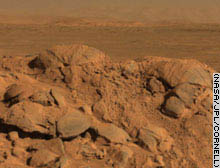
A photo in almost natural colors was taken by the Spirit vehicle and it shows a field of rocks and alluvial plains in Gosev Crater
Direct link to this page: https://www.hayadan.org.il/mars220804.html
The hills of Mars this week provided more spectacular clues about the way water shaped the Red Planet in experiments conducted by the robot geologist Spirit, while its twin, Opportunity, continues his research inside the deep crater he entered about two months ago. This is what the scientists of the operation said on Wednesday.
The scientists at the Jet Propulsion Laboratory in Pasadena, Calif., said Spirit revealed an array of bedrock that showed signs of being once covered by water and likely also provided clues about the planet's ancient atmosphere.
The scientists believe the bedrocks were thrown up from where they were below the surface of the lava-covered Gosev Crater, where the Spirit landed on January 3 and spent months traversing it to reach the series of cliffs that have been named the Columbia Hills.
During the last week, the vehicle performed a series of experiments on the rock known as Clovis that rises nine meters above the plain. This is what the chief scientist in the project, Steve Squires, said on Wednesday.
Both Spirit and Opportunity found ancient evidence of water on Mars earlier in their mission, but new data taken by Spirit's science instruments this week suggests that the life-giving liquid was once more abundant than previously thought. This is the difference between these rocks and the rocks on the plain that we saw covered and cracked, as a result of the effect of a small amount of water. Yes, we have a deeper change, and this indicates that there was much more water." Clovis, by the way, lies among other rocks that don't seem to have been covered by water.
"Right now we have evidence that this rock, Clovis, was in contact with liquid water," Squires said. "We need to understand whether it is hot or cold water or gas. This will tell us a lot about the way the rock is changed by the water.
Opportunity, which landed on a flat gray plain on the far side of Mars that was probably once a salt sea, is also preparing to explore a dune field inside Endurance Crater, where it has been operating since June.
The six-legged vehicles operate in the harsh atmosphere of Mars. Twice the time for which they were designed, but they are already starting to suffer from minor technical problems. One of Spirit's propellers lost power while Opportunity's rock drill broke down twice this week, engineers said.
https://www.hayadan.org.il/BuildaGate4/general2/data_card.php?Cat=~~~930750637~~~16&SiteName=hayadan
